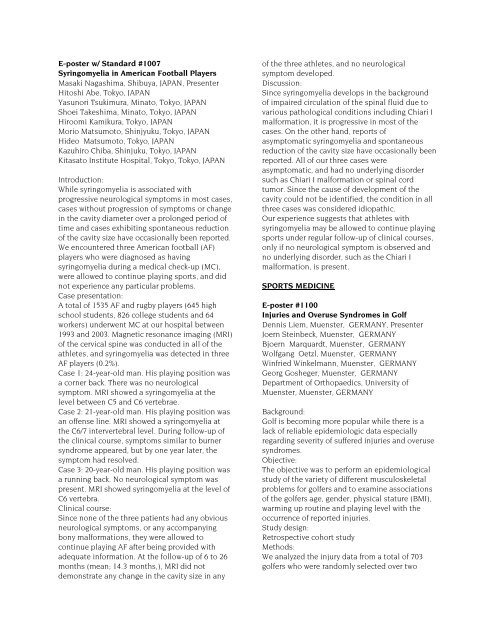POSTER ABSTRACTS - ISAKOS
POSTER ABSTRACTS - ISAKOS
POSTER ABSTRACTS - ISAKOS
You also want an ePaper? Increase the reach of your titles
YUMPU automatically turns print PDFs into web optimized ePapers that Google loves.
E-poster w/ Standard #1007<br />
Syringomyelia in American Football Players<br />
Masaki Nagashima, Shibuya, JAPAN, Presenter<br />
Hitoshi Abe, Tokyo, JAPAN<br />
Yasunori Tsukimura, Minato, Tokyo, JAPAN<br />
Shoei Takeshima, Minato, Tokyo, JAPAN<br />
Hiroomi Kamikura, Tokyo, JAPAN<br />
Morio Matsumoto, Shinjyuku, Tokyo, JAPAN<br />
Hideo Matsumoto, Tokyo, JAPAN<br />
Kazuhiro Chiba, Shinjuku, Tokyo, JAPAN<br />
Kitasato Institute Hospital, Tokyo, Tokyo, JAPAN<br />
Introduction:<br />
While syringomyelia is associated with<br />
progressive neurological symptoms in most cases,<br />
cases without progression of symptoms or change<br />
in the cavity diameter over a prolonged period of<br />
time and cases exhibiting spontaneous reduction<br />
of the cavity size have occasionally been reported.<br />
We encountered three American football (AF)<br />
players who were diagnosed as having<br />
syringomyelia during a medical check-up (MC),<br />
were allowed to continue playing sports, and did<br />
not experience any particular problems.<br />
Case presentation:<br />
A total of 1535 AF and rugby players (645 high<br />
school students, 826 college students and 64<br />
workers) underwent MC at our hospital between<br />
1993 and 2003. Magnetic resonance imaging (MRI)<br />
of the cervical spine was conducted in all of the<br />
athletes, and syringomyelia was detected in three<br />
AF players (0.2%).<br />
Case 1: 24-year-old man. His playing position was<br />
a corner back. There was no neurological<br />
symptom. MRI showed a syringomyelia at the<br />
level between C5 and C6 vertebrae.<br />
Case 2: 21-year-old man. His playing position was<br />
an offense line. MRI showed a syringomyelia at<br />
the C6/7 intervertebral level. During follow-up of<br />
the clinical course, symptoms similar to burner<br />
syndrome appeared, but by one year later, the<br />
symptom had resolved.<br />
Case 3: 20-year-old man. His playing position was<br />
a running back. No neurological symptom was<br />
present. MRI showed syringomyelia at the level of<br />
C6 vertebra.<br />
Clinical course:<br />
Since none of the three patients had any obvious<br />
neurological symptoms, or any accompanying<br />
bony malformations, they were allowed to<br />
continue playing AF after being provided with<br />
adequate information. At the follow-up of 6 to 26<br />
months (mean; 14.3 months,), MRI did not<br />
demonstrate any change in the cavity size in any<br />
of the three athletes, and no neurological<br />
symptom developed.<br />
Discussion:<br />
Since syringomyelia develops in the background<br />
of impaired circulation of the spinal fluid due to<br />
various pathological conditions including Chiari I<br />
malformation, it is progressive in most of the<br />
cases. On the other hand, reports of<br />
asymptomatic syringomyelia and spontaneous<br />
reduction of the cavity size have occasionally been<br />
reported. All of our three cases were<br />
asymptomatic, and had no underlying disorder<br />
such as Chiari I malformation or spinal cord<br />
tumor. Since the cause of development of the<br />
cavity could not be identified, the condition in all<br />
three cases was considered idiopathic.<br />
Our experience suggests that athletes with<br />
syringomyelia may be allowed to continue playing<br />
sports under regular follow-up of clinical courses,<br />
only if no neurological symptom is observed and<br />
no underlying disorder, such as the Chiari I<br />
malformation, is present.<br />
SPORTS MEDICINE<br />
E-poster #1100<br />
Injuries and Overuse Syndromes in Golf<br />
Dennis Liem, Muenster, GERMANY, Presenter<br />
Joern Steinbeck, Muenster, GERMANY<br />
Bjoern Marquardt, Muenster, GERMANY<br />
Wolfgang Oetzl, Muenster, GERMANY<br />
Winfried Winkelmann, Muenster, GERMANY<br />
Georg Gosheger, Muenster, GERMANY<br />
Department of Orthopaedics, University of<br />
Muenster, Muenster, GERMANY<br />
Background:<br />
Golf is becoming more popular while there is a<br />
lack of reliable epidemiologic data especially<br />
regarding severity of suffered injuries and overuse<br />
syndromes.<br />
Objective:<br />
The objective was to perform an epidemiological<br />
study of the variety of different musculoskeletal<br />
problems for golfers and to examine associations<br />
of the golfers age, gender, physical stature (BMI),<br />
warming up routine and playing level with the<br />
occurrence of reported injuries.<br />
Study design:<br />
Retrospective cohort study<br />
Methods:<br />
We analyzed the injury data from a total of 703<br />
golfers who were randomly selected over two
















